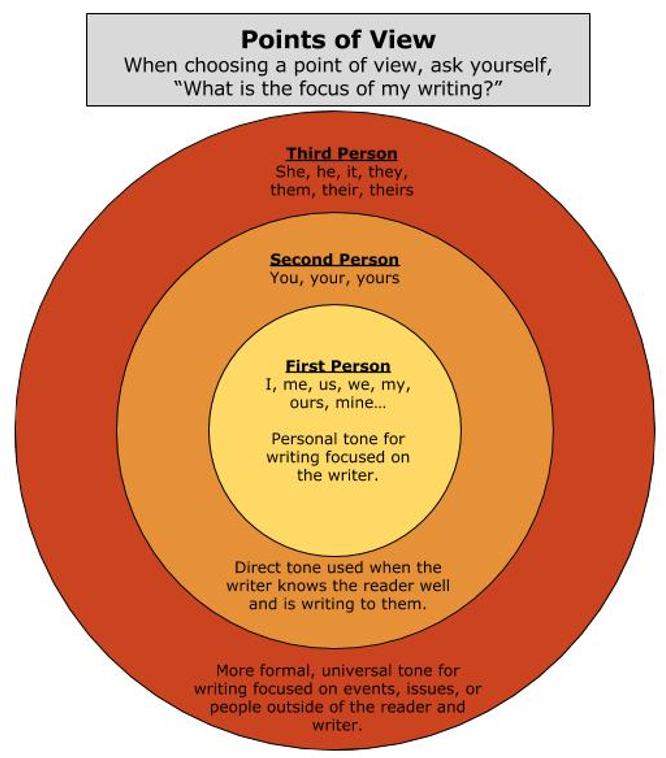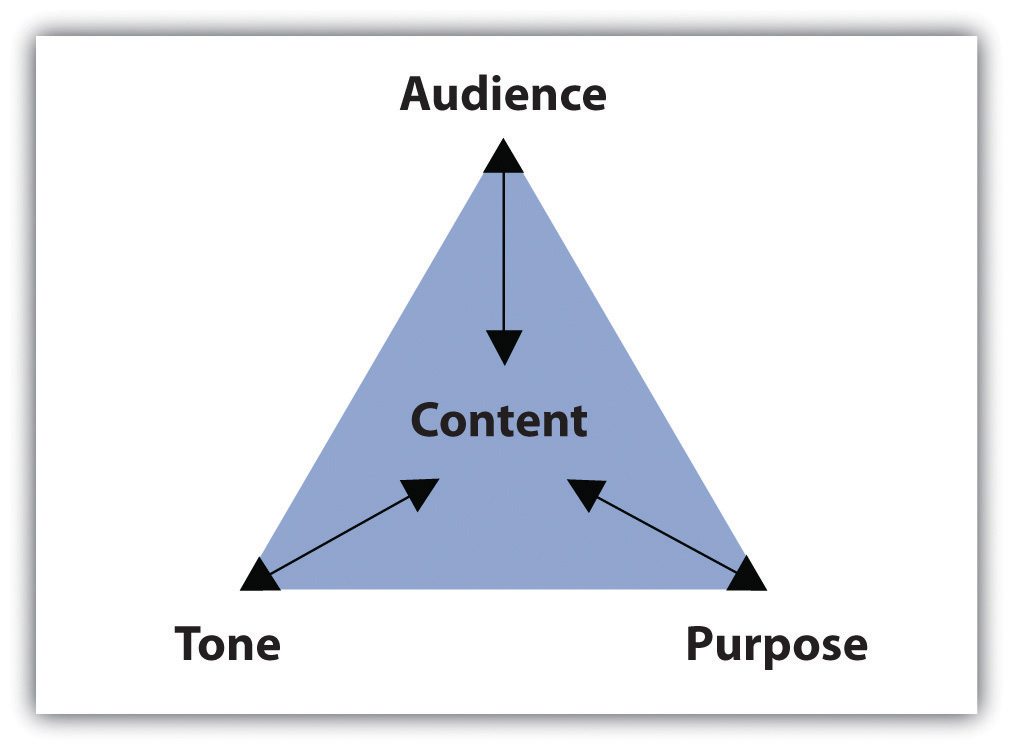2 Purpose, Audience, Tone, Content, and Point of View
Purpose, Audience, Tone, and Content
Learning Objectives
- Identify the four common academic purposes.
- Identify audience, tone, and content.
- Apply purpose, audience, tone, and content to a specific assignment.
Imagine reading one long block of text, with each idea blurring into the next. Even if you are reading a thrilling novel or an interesting news article, you will likely lose interest in what the author has to say very quickly. During the writing process, it is helpful to position yourself as a reader. Ask yourself whether you can focus easily on each point you make. One technique that effective writers use is to begin a fresh paragraph for each new idea they introduce.
Paragraphs separate ideas into logical, manageable chunks. One paragraph focuses on only one main idea and presents coherent sentences to support that one point. Because all the sentences in one paragraph support the same point, a paragraph may stand on its own. To create longer assignments and to discuss more than one point, writers group together paragraphs.
Three elements shape the content of each paragraph:
- Purpose. The reason the writer composes the paragraph.
- Tone. The attitude the writer conveys about the paragraph’s subject.
- Audience. The individual or group whom the writer intends to address.
Figure 6.1 Purpose, Audience, Tone, and Content Triangle
The assignment’s purpose, audience, and tone dictate what the paragraph covers and how it will support one main point. This section covers how purpose, audience, and tone affect reading and writing paragraphs.
Identifying Common Writing Purposes
The purpose of a piece of writing identifies the reason you write a particular document. Basically, the purpose of a piece of writing is to answer the question, “Why?” For example, why write a play? To entertain a packed theatre. Why write instructions to the babysitter? To inform him or her of your schedule and rules. Why write a letter to your congressman? To persuade him to address your community’s needs.
The reasons for writing fulfill three main purposes: to inform, to entertain, or to persuade. You will encounter these three purposes not only as you read for your classes but also as you read for work or pleasure.
Eventually, your instructors will ask you to complete assignments specifically designed to meet one of the three purposes. As you will see, the purpose of writing will guide you through each part of the paper, helping you make decisions about content and style.
Tone, Voice, and Point of View
Yo! Wassup?
Hey, how you doin’?
Hello, how are you today?
Which of the above greetings sounds most formal? Which sounds the most informal? What causes the change in tone?
Your voice can’t actually be heard when you write, but it can be conveyed through the words you choose, the order you place them in, and the point of view from which you write. When you decide to write something for a specific audience, you often know instinctively what tone of voice will be most appropriate for that audience: serious, professional, funny, friendly, neutral, etc.
For a discussion of analyzing an author’s point of view when reading a text, see Point of View in the “Writing about Texts” section.
What is point of view, and how do I know which one to use?
Point of view can be tricky, so this is a good question. Point of view is the perspective from which you’re writing, and it dictates what your focus is. Consider the following examples:
- I love watching the leaves change in the fall. (First person point of view)
- You will love watching the leaves change color. (Second person)
- The leaves in fall turn many vibrant colors. (Third person)
Which of the above sentences focuses most clearly on the leaves? Third person, right? The first person sentence focuses on what “I” love and the second person sentence focuses on what “you” will love.
- First person uses the following pronouns: I, me, my, us, we, myself, our, ours … any words that include the speaker/writer turn the sentence into first person.
- Second person uses any form of the word “you,” which has the effect of addressing the reader.
- Third person uses pronouns like he, she, it, they, them … any words that direct the reader to a person or thing that is not the writer or reader turn the sentence into third person.
That’s a lot to think about. When is it okay to use each of these points of view?

Many of your college instructors will ask you to write in third person only and will want you to avoid first or second person. Why do you think that is? One important reason is that third person point of view focuses on a person or topic outside yourself or the reader, making it the most professional, academic, and objective way to write. The goal of third person point of view is to remove personal, subjective bias from your writing, at least in theory. Most of the writing you will do in college will require you to focus on ideas, people, and issues outside yourself, so third person will be the most appropriate. This point of view also helps your readers stay focused on the topic instead of thinking about you or themselves.
The best answer to your question is that the point of view you choose to write in will depend on your audience and purpose. If your goal is to relate to your audience in a personal way about a topic that you have experience with, then it may be appropriate to use first person point of view to share your experience and connect with your audience.
The least commonly used point of view is second person, especially in academic writing, because most of the time you will not know your audience well enough to write directly to them. The exception is if you’re writing a letter or directing your writing to a very specific group whom you know well. (Notice that I’m using second person in this paragraph to directly address you. I feel okay about doing this because I want you to do specific things, and I have a pretty good idea who my audience is: reading and writing students.) The danger of using second person is that this point of view can implicate readers in your topic when you don’t mean to do that. If you’re talking about crime rates in your city, and you write something like, “When you break into someone’s house, this affects their property value,” you are literally saying that the reader breaks into people’s houses. Of course, that’s not what you mean. You didn’t intend to implicate the readers this way, but that’s one possible consequence of using second person. In other words, you might accidentally say that readers have done something that they haven’t or know, feel, or believe something that they don’t.
![]()
Even when you intend to use third person in an academic essay, it’s fine in a rough draft to write “I think that” or “I believe” and then to delete these phrases in the final draft. This is especially true for the thesis statement. You want to eliminate the first person from the final draft because it moves the focus—the subject and verb of the sentence—to the writer rather than the main point. That weakens the point because it focuses on the least important aspect of the sentence and also because it sounds like a disclaimer. I might say “I think” because I’m not sure, or “I believe” because I want to stress the point that this is only my opinion. Of course, it’s okay to use a disclaimer if you really mean to do so, and it’s also fine to use first person to render personal experience or give an anecdote.


